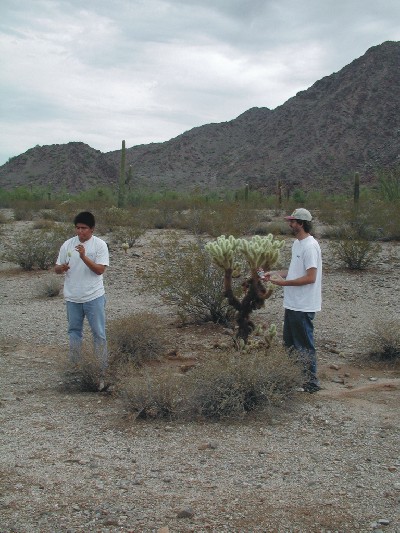
Collecting Cholla Buds for Science.
Craig Naseyowma and I collected 2 Teddy Bear cholla buds at the suggestion of Charlie Prewitt. He wanted to know if the needles could be used to mount microcrystals for x-ray diffraction. Normally the crystals are mounted on glass fibers, which scatter some of the x-rays and create noise that interferes with the signal from the microcrystals. Charlie's idea was that the cholla spines would be so thin and sharp that the microcrystals could be glued to their tips instead of to glass fibers, and since (we thought) the cholla spines are composed of light carbon-based compounds that don't strongly scatter x-rays, that they would not interfere as much with the signal.
Here we are collecting the cholla buds, from near Happy Camp on the Mormon Trail:

The cholla spines were sent off to the Geophysical Laboratory. Charlie Prewitt and Chris Cahill tried them out at the synchrotron. Did it work? Unfortunately, no. The cholla spines turned out to contain some form of silica, which has quite a high scattering of x-rays and created a signal of its own which interfered with the signal from the crystal.
We are not biologists! The fact that cholla spines contain silica must be known by biologists, but it surprised us a bit (although I have heard that there is silica in grasses). Why is is there? The silica may help to make the spine nice and hard, so it can dig deeper into the flesh of any animal that brushes past it. This acts as protection for the cholla, and also helps the plants to spread, since the bud dislodges easily from the parent plant, and a new cholla plant can grow from the bud wherever it falls.
If you have never felt the pain of making contact with a Teddy Bear cholla, you are missing out on one of the most impressive defenses in any plant. The spines are very sharp and can imbed themselves deeply in your skin. They stick snugly and are very painful to pull out. This is because of tiny, umbrella-like rings of cells that project backward from the tip, along the entire length of the spine, and act as miniature barbs. They are worse than any barb ever designed by man that I am aware of, they make fishooks look like a joke. I hope to take a microscopic image of them for this page someday soon, since words can hardly do them justice.
The animals I know of that use cholla buds are the packrat, which collects them to put around its burrows as protection, and the cactus wren, which nests in the cholla, also for protection.